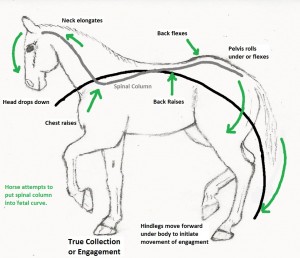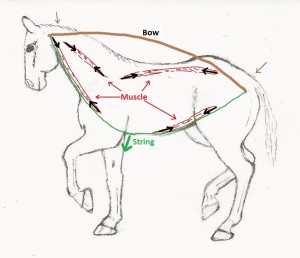Equine Gait Collection or commonly referred to as collection, true collection, or engagement is the biomechanical mechanism in which a horse initiates movement or a gait. Proper equine biomechanical function as discussed in Equine Biomechanics of Locomotion is essential for athletic performance and soundness. Loss of true collection or engagement alters the proper equine biomechanical motion resulting in abnormal force and wear on anatomical structures like joints or tendons and ligaments. These structures are not designed to handle the increased stress and abnormal use of improper equine biomechanics. Since a horse is powered by his hindquarters, he must put his body in a collective or engaged form to move. The only exception to this is the grazing amble. Collection of the body occurs to some degree in all gaits with faster gaits being more dramatic in their degree of collection. When the horse stops, they also put themselves into a musculoskeletal collective or engaged form to slow down or stop.

Equine Gait Collection
The equine gait collection or engagement with proper equine biomechanics starts by moving a hind leg forward under the horse’s belly. As the hind leg moves forward, the pelvis will tilt at an angle with the tail end going down causing the lumbar end of the pelvis to elevate. As the cranial or front end of the pelvis rises, the lumbar and thoracic parts of the spine also elevate. With the elevation of the cranial thoracic and lower cervical spine the curve at the base of the neck is flattened. As the neck lengthens, the lower neck rises with the cranial thorax to continue the arch created by the lumbar and thoracic spine. The head hanging on the end of the spine will drop. When viewed from the side the spine will progress to a fetal curved-type of position. An illustration of this posture in suspended animation would be a reining horse during a sliding stop.
Bow and String Apparatus
This curvature of the spine is enhanced by the function of “Bow and String” apparatus. The spine is the bow with the ventral or lower muscles of the abdomen and neck making up the string. As the string is tightened, potential energy is stored in the curved spine. This potential energy allows the horse to move faster and for longer distances before fatiguing. As you can see, the flexibility and curvature of the spine is key in transferring the power of the hindquarters to the rest of the horse for efficient locomotion.

Moving the Center of Gravity
In order to produce motion, the horse pushes the center of gravity forward. This occurs as energy for motion is passed from the hind legs through the pelvis into the lumbar and thoracic spine causing the center of gravity to move forward. The fore limbs are the power steering of the horse; therefore they are not designed to contribute a significant amount of energy into forward motion rather they determine the direction of movement with power. The head and neck are used as a counter-balance mechanism for the forces of movement.
Essentially, equine gait collection is a sequence of muscle contractions with limb and vertebral movement to orient the body and spine into a fetal curve position. This provides and stores energy to move the center of gravity in a specific direction and manner, allowing the horse to perform its required task. As you can see, proper and full range of motion of the spine and pelvis is very important for the horse to perform their desired function. In future blogs we will discuss false collection, how to recognize it, and why it is so detrimental to the well-being of our equine companions and partners.
